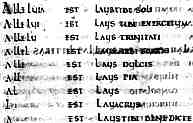|
|
|
|
|
 |
|
Abbreviations |
| The
process of production of manuscript
books and documents was laborious and slow, so it is not surprising that
standard forms of abbreviation of words became widely used. What may be
a little surprising is some of the kinds of words that were abbreviated
and the types of works in which abbreviations commonly occur. It is not
simply a case that very formal works were written out in full while more
rapidly written works were heavily abbreviated. In some cases abbreviation
has a different significance. |
| There
is some system in the way that Latin words were abbreviated, with certain
prefixes and suffixes shortened in a standard way. There are also standard
lists of abbreviated Latin words that can be consulted. |
|
The
presence of abbreviations can be recognised by the use of standard abbreviation
marks. Usually these are simple slashes through or above letters, but
occasionally the abbreviation marks are quite elaborate and seem to represent
a calligraphic
flourish rather than a saving of time or effort. An example is the papal
knot. |
 |
Sample from an early 12th century English royal charter (British Library, Campbell Charters xxi 6). By permission of the British Library. |
|
The above example shows abbreviations
to the words archiepiscopus Willelmus (Archbishop
William) are indicated by a simple hooked line above the letters ps and a slash through ll. |
 |
Sample from a papal bull of 1127 (Saint
Gall, Stiftsarchiv, Abteilung Pfaefers, III 6 a). |
|
The
characteristic figure of eight abbreviation mark known as a papal knot
is part of the elaborate calligraphy of this papal bull. These elaborations were
also found on German imperial diplomas of the period. The abbreviated
words are episcopum and episcoporum,
the suffix indicated by the standard elongated r with a slash through it. |
| A
very special form of abbreviation was used for particularly sacred words,
including the names of the deity. These abbreviations for the so-called
nomina sacra
were used in the most formal and precisely written works. They seem to
represent something psychologically interesting; a desire not to look
God too closely in the face or a metaphorical aversion of the eyes in
the presence of the most holy concepts. They are not there to save space
or speed up production, but as a symbol of something significant. |
 |
Segment from an 8th century gospel (British Library Royal 1 B VII, f.55). By permission
of the British Library. |
|
This
segment
is an abbreviation for iesu christi filii dei (Jesus Christ the son of God). |
 |
Segment from the 8th century Vespasian Psalter (British
Library, Cotton Vespasian A1).By permission of the British Library. |
|
In
this rather unusual example, the word alleluia is progressively shortened in each line, creating visual patterning on
the page. |
| When
it came to writing at speed, systems of shorthand were known in Classical
antiquity. One in particular, the Tironian
notes, was in use until around the 10th century. However, it fell
out of use with the exception of a few surviving symbols, the most common
being the symbol for et. Rapid writing, and
the sort of crammed writing that was used in the glosses of university texts to fit masses of material on to a page, used extensive
abbreviation rather than special systems of shorthand symbols. |
 |
Samples
of Tironian notes from a 10th century manuscript (British Library, add. ms.
37518, f.41). |
 |
Sample from a 12th century charter
(British Library, Campbell Charters xi 6). By permission of the British
Library. |
|
The above example shows the
Tironian et in the first word, as used for many centuries before it was overtaken by the symbol which we describe today as an ampersand. |
| Abbreviations
took a number of forms. For some small words or words in common use in
documents there was a very brief standard abbreviation. Some combinations
of letters within a word were abbreviated in a standard way in different
words. Proper nouns such as names of people and places also had specific
abbreviations. As well as the contraction marks of hooks or slashes, superscript
letters were used to differentiate similar contractions. Some of the abbreviations
developed for the Latin language were carried over into English, although
vernacular
languages do not seem to have employed contractions to the same degree
as some of the more heavily abbreviated Latin texts. |
|
Nomina
Sacra |
|
Common
Words |
|
Contractions
within Words |
|
Proper
Nouns |
|
English
Abbreviations |
 What
is Paleography? What
is Paleography? |
|
 |
 |
 |
 |
 |



![]()
![]()
![]()
![]()